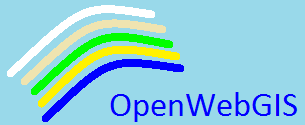

1. Facebook
2. Google+
3. LiveJournal
4. Blogspot




This video shows an example of contouring (in this case the isotherms) in the online GIS (geographic information system) OpenWebGIS
The input data is the temperature data of the system: The Integrated Global Ocean Services System (IGOSS).
The data correspond to monthly average temperature on the surface of the earth in November 2013, with reference to the centers of degree squares.
Spatial data are limited in longitude from 17W to 64W, in latitude: 2S to 27N.
Data are taken in the form of a table in CSV format from the site International Research Institute for Climate and Society .
The column in the table which contains the temperature is called SST (Sea Surface Temperature).
As a result, the user is getting a vector layer (WFS) of isotherms.
The weather information is taken from two sources: http://www.worldweatheronline.com and http://www.openweathermap.org



This search of the object on the map is based on the Nominatim tool (from the Latin, 'by name'). That is a tool to search OSM data by name and address
and to generate synthetic addresses of OSM points (reverse geocoding). It can be found at http://nominatim.openstreetmap.org

You can get the path computation after pressing the button with the question mark in the top right hand map corner.
The result with this information about each part of the route can be exported to kml and gml format.
The computation is based on the service http://project-osrm.org

In this video interface of
OpenWebGIS system is shown in brief, as well as the result of one of its functions work called Time Line. You see the animation of Hurricane Katrina movement in august 2005. The data is taken in the form of csv file from the site http://cs.furman.edu/~pbatchelor/csc105/assignments/Mapping%20Labs/HurricanesBeerMoney.html
The hurricane photos from the satellite were taken from here www.tropicalweather.net,www.nola.com,discoverhistorictravel.com.
In the video the hurricane movement is shown by days. There are 4 location marks and wind speed marks -Wd_sp for every 24 hours. The hurricane rotation speed is changing in percents from absolute speed maximum. Please support the project OpenWebGIS: open and free GIS online for all of us.
In OpenWebGis there is now the opportunity to load in the user’s working area raster files of not only ArcGrid format, but also GeoTiff. It can be done by choosing menu item Edit->Load GeoTiff file'. The functions for work with rasters were enriched in the geomathematics section (menu item 'Calculations->Geomatematics'). When selecting WPS function (all functions in geomatimatics list work according to WPS standard) for the work with rasters it is possible to choose raster layer (GeoTiff or ArcGrid) in the layer list, which has already been loaded on the server and besides it is possible to make all necessary calculations with it. If you have the ArcGrid file in your computer then you can make the same operations without loading on the server. For doing so the only thing you need is to press the button Select file. After that file content must appear in the Input field:. Then select necessary parameters and press Execute button.
At last function pan and zoom map to the layer is added. It is in menu item "Layers"->"Zoom to Layer". When selecting this menu item map extent is changed in such way that all element of the layer selected in the list 'Editable Layer', will be shown in the map area you see. Let us describe the list 'Editable Layer' in more detail. While working with OpenWebGIS it is important to remember that in order to add,delete, modify elements in the layer or open its attribute table etc. you need to select the name of appropriate layer in the list 'Editable Layer'.
At the moment you are able to create 3d scatter plots on the base of both your layers data and mathematical functions, for example:
z=x^2-y^2.


You can experiment on this function if after you have selected the editable layer you choose menu item 'Edit'-> 'Open atribute table '. Then you need to select fields for all three axis in the block 'Chart'.